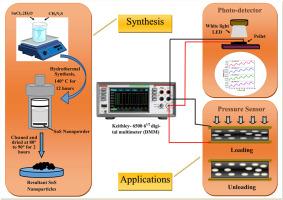水热合成双功能硫化锡纳米粒子:光子响应和压力传感应用
IF 2.4
4区 物理与天体物理
Q3 PHYSICS, CONDENSED MATTER
引用次数: 0
摘要
硫化锡纳米颗粒具有直接带隙、无毒性和成本效益等显著特性,具有广泛的应用前景。本研究的重点是利用成本低廉的水热法合成SnS纳米颗粒,并对其进行综合表征。能量色散x射线光谱分析和扫描电子显微镜分析通过检查成分和表面形貌证实了高纯度和正交状结构。采用高分辨透射电镜和选定区域电子衍射进行平面验证。x射线光电子能谱分析暗示了Sn和S的能级,旨在确定结合状态和化学组成。x射线衍射提供了晶体尺寸为30.80 nm的晶体学参数的详细信息。紫外-可见光谱显示带隙为1.62 eV,适合于光转换应用。纳米颗粒表现出光照依赖的光响应,具有增强的光电流和低陷阱密度,表明具有光驱动功能的潜力。此外,该研究还展示了将SnS纳米颗粒集成到柔性PVA/PU海绵压力传感器中,在3.92-13.7 kPa的压力范围内实现了13.105 kPa−1的灵敏度。这种结合光探测和敏感压力传感应用的双重功能使SnS纳米颗粒成为下一代光电和可穿戴传感器技术的通用材料。本文章由计算机程序翻译,如有差异,请以英文原文为准。

Hydrothermally synthesized dual-functional tin (II) sulfide nanoparticles: Photonic response and pressure sensing applications
Tin (II) sulfide (SnS) nanoparticles exhibit notable characteristics such as a direct band gap, non-toxicity, and cost-effectiveness, making them attractive for diverse applications. This research focuses on synthesizing SnS nanoparticles using a budget-friendly hydrothermal method and conducting comprehensive characterization. Energy-dispersive X-ray spectroscopy and scanning electron microscopy analyses confirmed the high purity and orthorhombic-like structure by examining composition and surface morphology. High resolution transmission electron microscopy with selected area electron diffraction was carried out for plane validation. X-ray photoelectron spectroscopy implies the energy levels of Sn and S, aiming to determine binding states and chemical composition. X-ray diffraction provided detailed information on the crystallographic parameters with 30.80 nm crystallite size. Ultraviolet–Visible spectroscopy indicated a band gap of 1.62 eV, suitable for light conversion applications. The nanoparticles exhibited illumination-dependent photo-response, with enhanced photocurrent and low trap density indicating potential for light-driven functionalities. Additionally, this study demonstrates the integration of SnS nanoparticles into flexible PVA/PU sponge-based pressure sensor, achieving a sensitivity of 13.105 kPa−1 over a 3.92–13.7 kPa pressure range. This dual functionality combining photodetection with sensitive pressure sensing application makes SnS nanoparticles as a versatile material for next-generation optoelectronic and wearable sensor technologies.
求助全文
通过发布文献求助,成功后即可免费获取论文全文。
去求助
来源期刊

Solid State Communications
物理-物理:凝聚态物理
CiteScore
3.40
自引率
4.80%
发文量
287
审稿时长
51 days
期刊介绍:
Solid State Communications is an international medium for the publication of short communications and original research articles on significant developments in condensed matter science, giving scientists immediate access to important, recently completed work. The journal publishes original experimental and theoretical research on the physical and chemical properties of solids and other condensed systems and also on their preparation. The submission of manuscripts reporting research on the basic physics of materials science and devices, as well as of state-of-the-art microstructures and nanostructures, is encouraged.
A coherent quantitative treatment emphasizing new physics is expected rather than a simple accumulation of experimental data. Consistent with these aims, the short communications should be kept concise and short, usually not longer than six printed pages. The number of figures and tables should also be kept to a minimum. Solid State Communications now also welcomes original research articles without length restrictions.
The Fast-Track section of Solid State Communications is the venue for very rapid publication of short communications on significant developments in condensed matter science. The goal is to offer the broad condensed matter community quick and immediate access to publish recently completed papers in research areas that are rapidly evolving and in which there are developments with great potential impact.
 求助内容:
求助内容: 应助结果提醒方式:
应助结果提醒方式:


